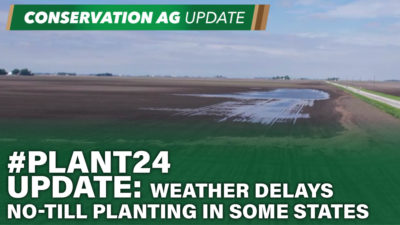A year ago today, a rare and intense dust storm caused a deadly 90-vehicle pileup on Interstate 55 in central Illinois. 55-mph winds carried soil from recently tilled fields across both lanes of the highway May 1, 2023, reducing visibility near zero. 8 people died as a result of the crash.
No-Till Legends Don Reicosky, Randall Reeder and Dave Brandt, along with longtime Ohio State University soil scientist Rattan Lal, wrote an essay pointing out the role of tillage in the crash and how the deadly pileup could have been avoided had the fields been no-tilled. They said education is key to preventing more deadly and destructive dust storms.
The deadly dust storm and the education necessary to prevent future tragedy resurfaced during a No-Till Innovator panel discussion at the 2024 National No-Tillage Conference in January. Reeder, retired USDA deputy secretary of agriculture Jim Moseley and No-Till Legend Ray McCormick speculated on the regulation that could come from tillage-related incidents:
Moseley: We had an exceptionally bad blow several years ago in the middle of the winter. I had farmed it for years, and it had been all no-till, but it went to seed production, and the seed company required moldboard plowing. I haven't gotten that logic yet, but it was a large track, and it was the middle of the winter, frozen ground, and the outcome was just you couldn't see 300-400 feet away from where you were because the dust was so bad.
Dust comes at all times of the year, and it's all dependent upon the conditions, but the fact that we're bearing this soil in large quantities across the Midwest does not bode well. I've worked in the policy arena for 30 years, and the moment will arise when it will end up in the courts or in legislative bodies. There's going to be action taken. When that happens, farmers are going to be very unhappy because I think we're going to begin to see the insurance companies walk away from the great risks that are being felt. I-55 was really a major tragedy that I think has set the stage for that to happen.
Reeder: There are dust storms every year in different parts of the country. Don Reicosky researched and found a stretch in Arizona along Interstate 10 between Tucson and Phoenix where there are frequent dust storms, and once in a while, there'll be a tragic accident. The state of Arizona actually paid to spray many acres of farmland with a product that would control the dust. It was extremely expensive to spray and cover that land, and guess what that farmer did the next year? They went in and tilled it up, destroying that million-dollar application of a product to prevent the dust.
McCormick: When I took agricultural law at Colorado State University, for the standard by which liability incurred, the professor asked, “What would a reasonable person have done?” In this case, there would probably be evidence that those bare soils blew across that highway a lot. It wasn't the first time — it was probably a yearly event. So in that case, a reasonable person would've said, “That's too dangerous, I shouldn't do that, and somebody's going to get hurt.” And people did get hurt. If I were on the jury, I would find him liable for the damages.
Reeder: That's a very logical conclusion, even from a law school.
McCormick: I could propose another scenario. I rented a farm that I'd driven by my 60-some years of life. It was a highly erodible farm that had been moldboard plowed, and then it had been disc and so forth. When I went to rent it, the landlord pulled out a sheet of paper and showed me how much money she had been spending every year for a bulldozer bill to fix the erosion on that farm. I said, "Rosemarie, I'm going to cover it up with a cover crop and no-till it, and you're never going to see that soil again." As soon as I did that, I had neighbors that came to me and said, "Thank God somebody is finally taking care of this farm." One person stopped and said, "Thank you. I'm tired of driving through the mud coming up to the stop sign every year because the road is covered with mud."
It's not just dust. When your land is melting away across a main road in this case, there might be some liability there. Taking care of the land affects more than just that piece of ground. It affects how people perceive the care of the land from the neighbors. People who don't have anything in relation to farming notice that topsoil going across that road.
Reeder: That brings up a good example from no-tiller John Aeschliman in the Palouse area of Washington state. John Aeschliman has no erosion running across any road or causing any sedimentation, but he found out it costs over $1 million dollars a year for the county to take eroded dirt soil off of the roadways. And John said, “Well, I didn't contribute any of that. Why don't they reduce my taxes?” There's a cost to society for bad practices that we're doing here, including erosion, as well as the dust storms.
McCormick: As well as dredging the Mississippi.
Related Content
Another Dust Storm Catastrophe 90 Years Later that No-Till Could Have Prevented







Post a comment
Report Abusive Comment